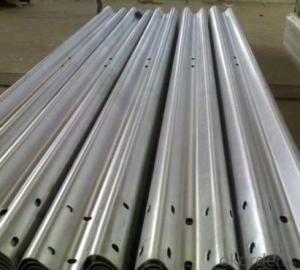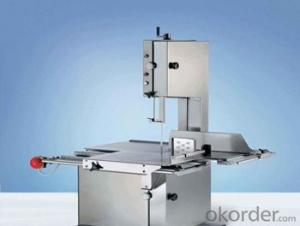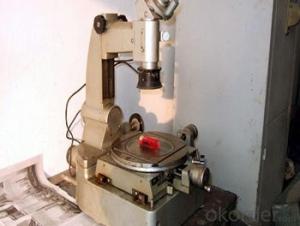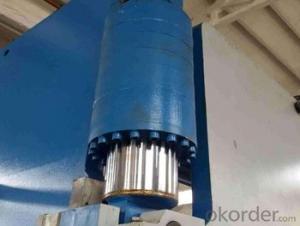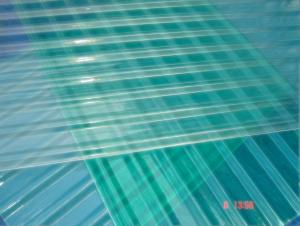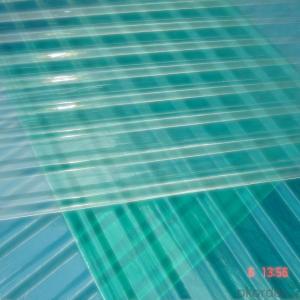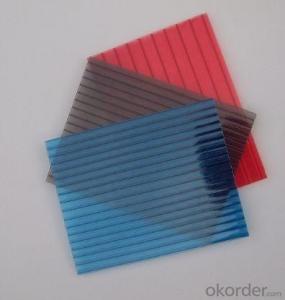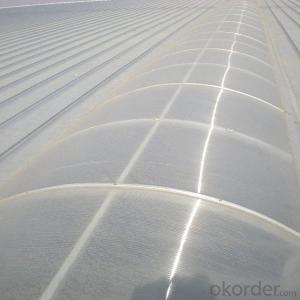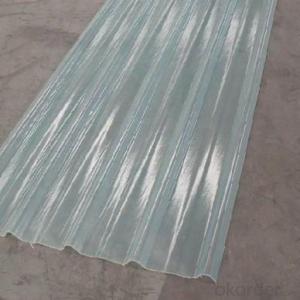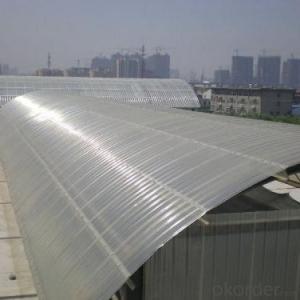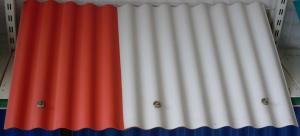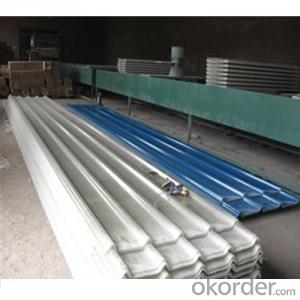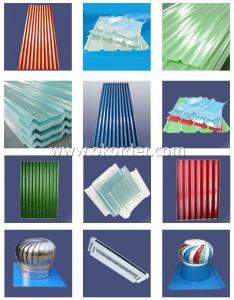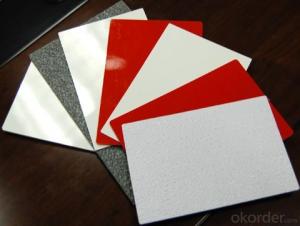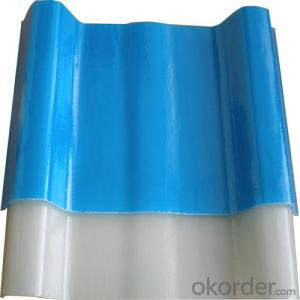FRP Translucent Fibreglass Corrugated Roofing Sheets
- Loading Port:
- Tianjin
- Payment Terms:
- TT OR LC
- Min Order Qty:
- 300 m
- Supply Capability:
- 80000 m/month
OKorder Service Pledge
OKorder Financial Service
You Might Also Like
Item specifice
PRODUCT DESCRIPTION
Fibreglass / Fiberglass Reinforced Plastic (FRP) or Glass Fiber Reinforced Plastic (GRP) is composed of thermosetting plastics and reinforced fiberglass, Greater than that of steel products and aluminum products in specific tenacity. Products in the ultra-low temperature or high temperature will not happen brittle fracture, deformation and to prevent heat transfer. Corrosion products in the environment anti-aging, yellowing resistance, corrosion resistance, friction resistance, easy to clean. Can be instead of aluminum, stainless steel plates, tiles and so on.
FEATURES
Corrosion resistance,last 10-15 years life span
Color stable.
Sound absorption and heat insulation.
Good water resistance.
Fireproof resistance.
Easy to install.
Good impact and low temperature resistance.
Light weight.
Stable volume.
SPECIFICATIONS
| Name: | Fibreglass Reinforced Polyester(FRP ) Sheet |
| Material: | Protective film, Unsaturated resin polyester, Fiberglass |
| Weight: | 1800g/2400g/2750g/3050g Square meter |
| Thickness: | 0.8~3.0mm |
| Length: | Customized |
| Temp: | used in -40°c to 140 °c |
| OEM: | Welcomed |
| Color: | Clear/Blue |
PICTURES
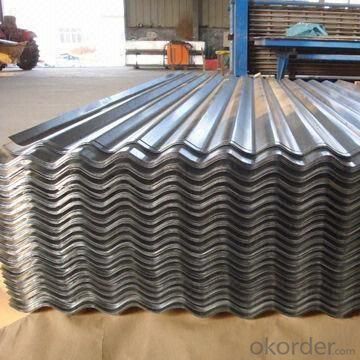
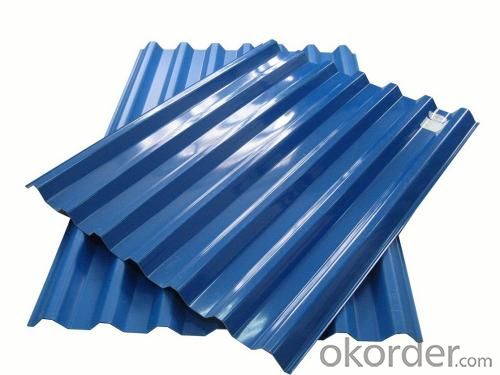
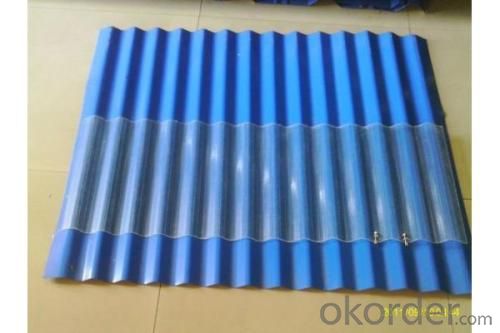
- Q:Can FRP roofing panels be used for bus shelters?
- Indeed, bus shelters can make use of FRP (Fiberglass Reinforced Plastic) roofing panels. These panels find widespread application in the architectural field owing to their sturdy composition, lightweight properties, and ability to withstand various weather elements like UV radiation, rain, and snow. Moreover, they boast exceptional insulation capabilities that aid in maintaining a pleasant temperature within the shelter. Furthermore, the installation process for FRP roofing panels is hassle-free, and they demand minimal upkeep, thereby making them an ideal selection for bus shelters that experience regular usage and exposure to outdoor conditions.
- Q:Can FRP roofing panels be used for both residential and commercial solar panel installations?
- Yes, FRP roofing panels can be used for both residential and commercial solar panel installations. FRP (fiberglass reinforced plastic) roofing panels are lightweight, durable, and provide excellent weather resistance. These qualities make them suitable for various applications, including solar panel installations. Whether it is a residential or commercial project, FRP roofing panels can effectively support and protect the solar panels, ensuring their longevity and optimal performance.
- Q:Can FRP roofing panels be used for airports?
- Yes, FRP (Fiberglass Reinforced Plastic) roofing panels can be used for airports. FRP panels are lightweight, durable, and resistant to corrosion, making them suitable for various applications including airports. They provide excellent protection against weather elements and can withstand high wind speeds. Additionally, FRP panels are easy to install, reducing construction time and costs.
- Q:Do FRP roofing panels require special ventilation?
- Yes, FRP (Fiberglass Reinforced Plastic) roofing panels do require special ventilation. Proper ventilation is necessary to prevent condensation and maintain the longevity of the panels. It helps to regulate temperature, reduce moisture buildup, and prevent potential damage to the panels and the underlying structure. Adequate ventilation also ensures better air quality and helps to prevent issues like mold and mildew growth.
- Q:Are FRP roofing panels resistant to bird droppings or other stains?
- Yes, FRP (Fiberglass Reinforced Plastic) roofing panels are generally resistant to bird droppings and other stains. The smooth, non-porous surface of FRP panels makes it difficult for bird droppings to adhere to the surface, making cleaning and maintenance easier. Additionally, FRP panels are often treated with a gel coating that provides an extra layer of protection against stains and discoloration. However, it is important to note that prolonged exposure to bird droppings or other harsh chemicals can potentially cause damage to the FRP panels over time. Regular cleaning and maintenance are still recommended to ensure the longevity and appearance of FRP roofing panels.
- Q:Are FRP roofing panels available in different sizes?
- FRP roofing panels can be found in various sizes, catering to different project needs. FRP, which stands for fiberglass reinforced panels, are widely chosen for roofing applications because of their strength, ability to resist corrosion and UV rays. These panels come in a range of dimensions, from small panels spanning a few feet in width and length to larger ones that can reach several feet in width and up to 20 or 30 feet in length. The variety of sizes available allows for easy installation and ensures that FRP roofing panels can be utilized in a multitude of structures and projects.
- Q:Can FRP roofing panels be used for modular or pre-fabricated buildings?
- Yes, FRP (Fiberglass Reinforced Plastic) roofing panels can be used for modular or pre-fabricated buildings. FRP panels are lightweight, durable, and easy to install, making them a suitable choice for such structures. They provide excellent insulation, UV resistance, and weatherproofing properties, ensuring the longevity and energy efficiency of modular or pre-fabricated buildings. Additionally, FRP roofing panels are available in various colors, profiles, and sizes, allowing for customization and flexibility in design. Overall, FRP roofing panels are a reliable and cost-effective option for modular or pre-fabricated buildings.
- Q:Can FRP roofing panels be used for commercial kitchens or food processing facilities?
- FRP roofing panels are suitable for commercial kitchens or food processing facilities. They are favored in these settings due to their toughness, minimal upkeep, and ability to withstand moisture, chemicals, and corrosion. Furthermore, these panels are lightweight, simplifying installation and handling. Moreover, FRP panels possess a smooth surface that is effortless to clean, a critical factor in maintaining hygiene standards in commercial kitchens and food processing facilities. Nonetheless, it is crucial to confirm that the FRP panels meet regulatory requirements and are installed correctly to guarantee a secure and compliant environment for food processing.
- Q:How are FRP roofing panels installed?
- FRP (Fiberglass Reinforced Plastic) roofing panels are typically installed in a sequence of steps that ensure a secure and weatherproof installation. Here is a general overview of how FRP roofing panels are installed: 1. Planning and Preparation: Before installation, it is important to thoroughly plan the roofing project. This includes measuring the roof area, ensuring proper flashing and trim materials are available, and acquiring all necessary tools and safety equipment. 2. Safety Measures: Safety should always be a top priority during the installation process. Installers should wear appropriate personal protective equipment (PPE) such as gloves, goggles, and non-slip shoes. Additionally, proper fall protection systems should be in place if working at heights. 3. Roof Surface Preparation: The existing roof surface should be cleaned and cleared of any debris or loose materials. It is important to ensure that the roof is structurally sound and capable of supporting the weight of the FRP panels. 4. Flashing and Trim Installation: Flashing and trim materials are essential for preventing water intrusion and providing a finished appearance. These components are typically installed first, using appropriate fasteners, adhesives, or sealants as recommended by the manufacturer. 5. Panel Layout and Measurement: Before installing the FRP panels, it is important to plan the layout and measure the roof area accurately. This helps to determine the number and size of panels required, ensuring a proper fit and minimizing waste. 6. Panel Installation: FRP panels are installed by positioning them on the roof surface and aligning them according to the predetermined layout. The panels are typically secured using screws or nails, with spacing and fastening methods specified by the manufacturer. It is important to follow the recommended installation guidelines to ensure proper panel alignment, sufficient fastening, and structural integrity. 7. Panel Sealing and Waterproofing: To ensure a watertight roof, it is important to seal the joints and edges of the FRP panels. This is typically done using sealants or adhesives recommended by the manufacturer. Proper sealing prevents water infiltration and protects the underlying roof structure. 8. Finishing Touches: Once the panels are securely installed and sealed, any remaining trim or flashing components are added to complete the installation. These finishing touches provide a clean and professional appearance while enhancing the overall durability of the FRP roofing system. It is important to note that the specific installation process may vary depending on the manufacturer's instructions, the type of FRP panels used, and the unique characteristics of the roof. Therefore, it is recommended to consult the manufacturer's installation guidelines for detailed instructions and best practices. Additionally, it is advisable to hire a professional roofing contractor with experience in FRP roofing installations for a safe and reliable installation process.
- Q:Can FRP roofing panels be used in areas with high levels of air pollution?
- Yes, FRP (Fiberglass Reinforced Plastic) roofing panels can be used in areas with high levels of air pollution. FRP panels are known for their durability and resistance to various environmental factors, including air pollution. They are designed to withstand harsh conditions and are often used in industrial and commercial settings where air pollution levels can be high. Additionally, FRP panels are non-reactive, meaning they do not corrode or degrade when exposed to chemicals or pollutants in the air. Therefore, they can be a suitable choice for areas with high levels of air pollution.
1. Manufacturer Overview |
|
|---|---|
| Location | |
| Year Established | |
| Annual Output Value | |
| Main Markets | |
| Company Certifications | |
2. Manufacturer Certificates |
|
|---|---|
| a) Certification Name | |
| Range | |
| Reference | |
| Validity Period | |
3. Manufacturer Capability |
|
|---|---|
| a)Trade Capacity | |
| Nearest Port | |
| Export Percentage | |
| No.of Employees in Trade Department | |
| Language Spoken: | |
| b)Factory Information | |
| Factory Size: | |
| No. of Production Lines | |
| Contract Manufacturing | |
| Product Price Range | |
Send your message to us
FRP Translucent Fibreglass Corrugated Roofing Sheets
- Loading Port:
- Tianjin
- Payment Terms:
- TT OR LC
- Min Order Qty:
- 300 m
- Supply Capability:
- 80000 m/month
OKorder Service Pledge
OKorder Financial Service
Similar products
New products
Hot products
Hot Searches
Related keywords
